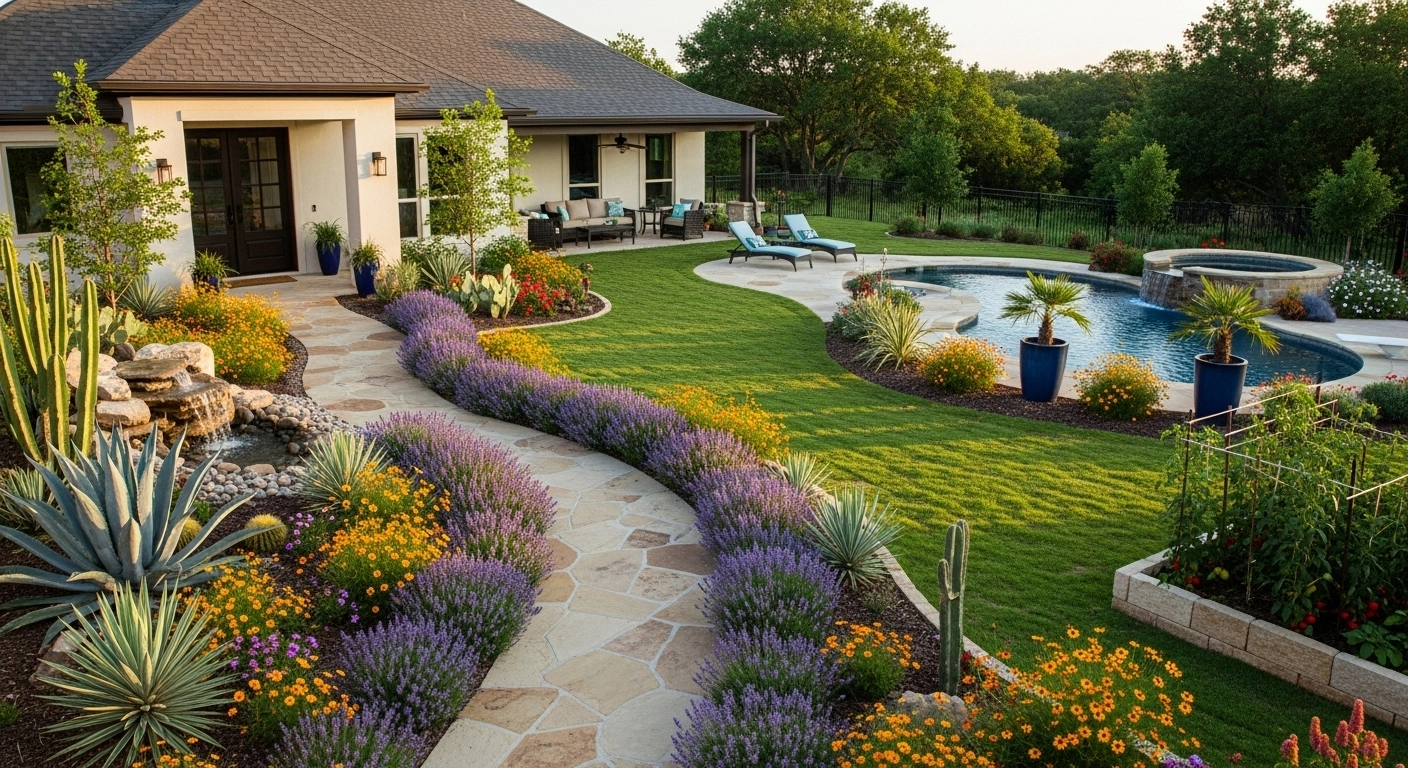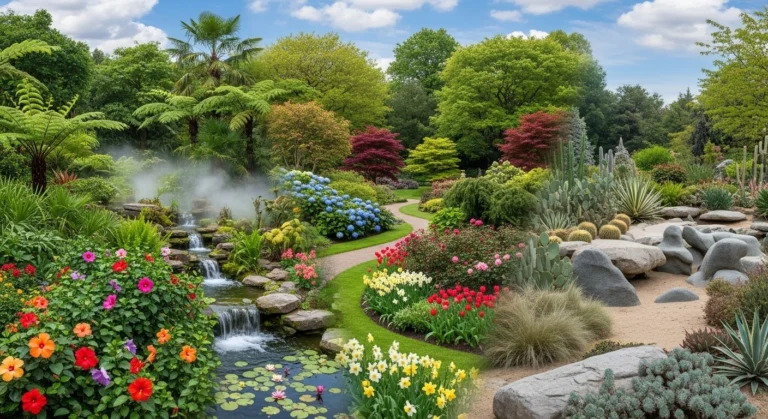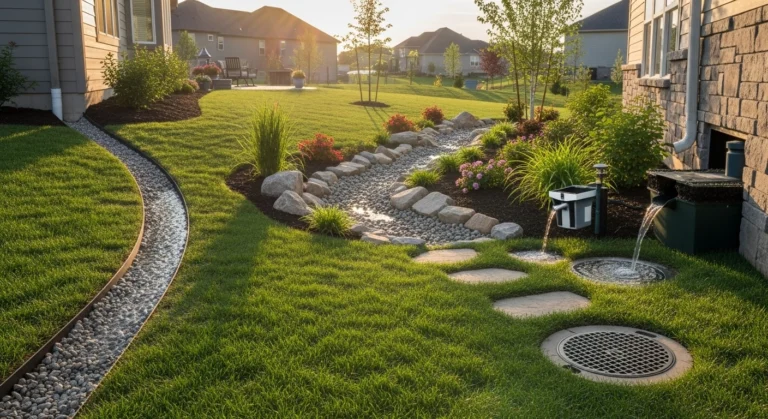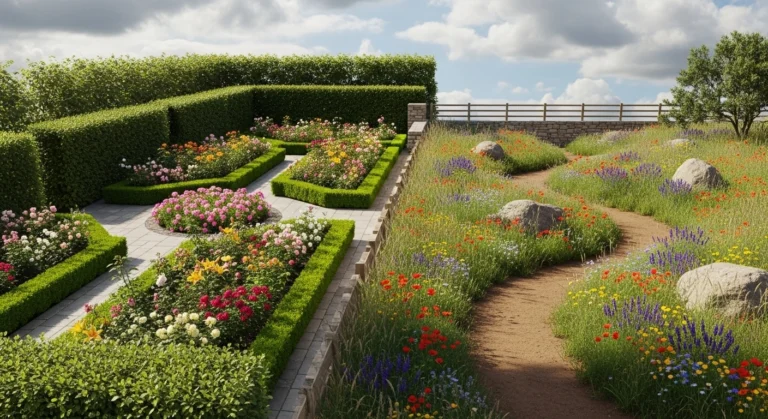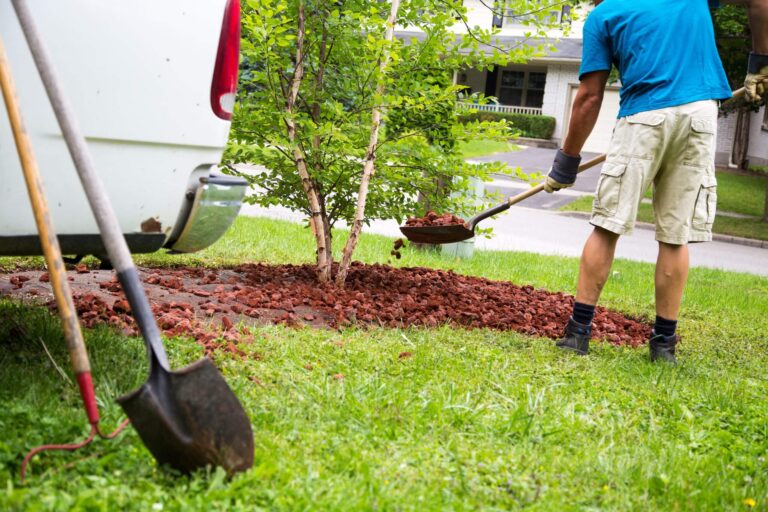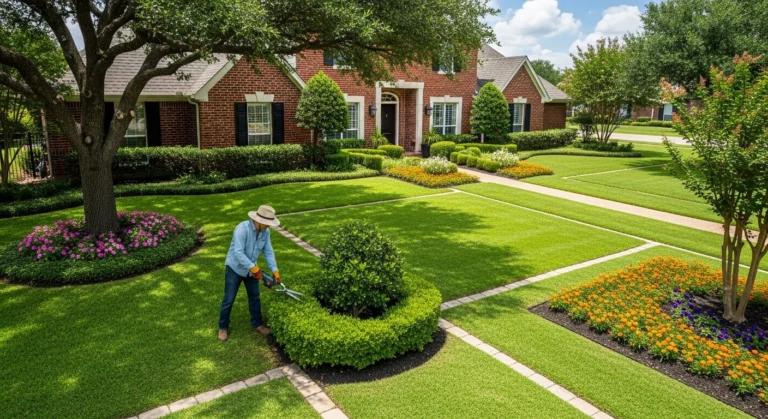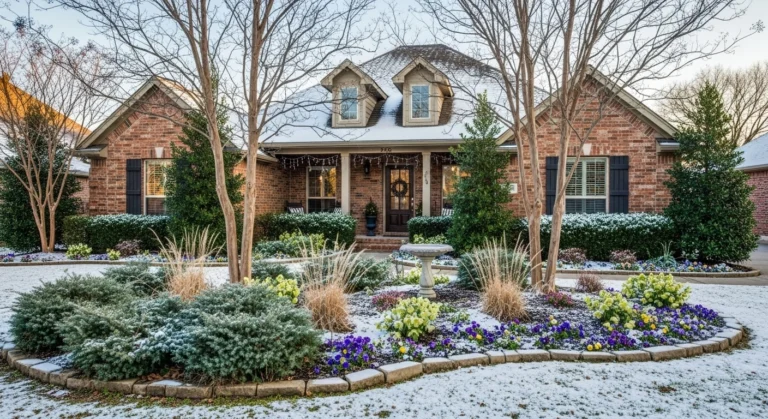You’re already dreading what you’ll find when you walk outside – crispy brown lawn edges, wilted flowers that looked fine yesterday, and that sinking feeling that your water bill is about to hit mortgage payment territory. Sound familiar? Every summer, I watch homeowners in our area wage the same losing battle against West Texas heat, throwing money at problems that keep getting worse despite their best efforts. The combination of 100+ degree days, relentless wind, and sporadic rainfall creates a perfect storm that can turn a beautiful spring landscape into a brown wasteland by August. After two decades of helping Lubbock families navigate these brutal summers, I can tell you that watching your outdoor investment slowly cook to death is one of the most frustrating experiences any homeowner faces.
But here’s what I’ve learned through years of trial, error, and success stories across our community – summer landscape survival isn’t about fighting the heat, it’s about working with it. The homeowners with gorgeous yards in August aren’t the ones watering twice daily or spending fortunes on replacement plants; they’re the smart ones who understand that summer preparation starts in spring and relies on strategic choices rather than brute force. Our Lawn Care Lubbock approach focuses on building heat resilience into your landscape before the temperature soars, not scrambling to fix problems after they appear. With the right techniques, timing, and plant selections, your yard can actually thrive during our challenging summers while using less water and requiring less maintenance than you might think possible. The secret is understanding what West Texas summers demand and giving your landscape exactly what it needs to not just survive, but flourish.
Why Summer Landscape Care Matters More in West Texas
Our climate here is uniquely challenging – we’re talking about conditions that would stress plants anywhere, combined with soil types and weather patterns that make standard gardening advice pretty much useless. The High Plains environment means intense UV radiation, constant wind that literally sucks moisture out of everything, temperature swings that can hit 40 degrees between night and day, and rainfall patterns that range from drought to deluge with no middle ground. Most landscaping information you’ll find online assumes conditions that simply don’t exist here.
The economic reality of poor summer landscape management hits hard. We’ve tracked homeowner expenses over multiple seasons, and families who don’t adapt their approach to our climate spend an average of 60% more on plant replacement, water bills, and emergency interventions than those who implement heat-smart strategies. That’s not just money – it’s time, frustration, and the disappointment of watching your outdoor efforts fail despite your best intentions.
Our Seasonal Landscape data shows that properly managed landscapes use 45% less water during peak summer months while maintaining better appearance and plant health than conventionally managed yards. The difference comes down to understanding that West Texas summers aren’t a season to endure – they’re a season to master.
Essential Summer Landscape Strategies That Actually Work
Water Management Beyond “Just Water More”
Forget everything you think you know about summer watering – more water isn’t the answer, smarter water is. The biggest mistake I see homeowners make is increasing frequency while ignoring timing, depth, and efficiency. Shallow, frequent watering actually trains plant roots to stay near the surface, making them even more vulnerable to heat stress and drought conditions.
Deep, infrequent watering builds heat resilience that carries plants through our worst weather. Water early morning (5-7 AM) when temperatures are coolest and wind speeds are lowest. This timing allows maximum soil penetration before evaporation kicks into high gear. Apply water slowly enough that it soaks in rather than running off – this might mean multiple short cycles with breaks between, especially on slopes or clay soils.
Your summer watering action plan:
- Install drip irrigation or soaker hoses in flower beds and around trees for efficient, deep water delivery
- Use the “screwdriver test” – if you can’t push a screwdriver 6 inches into your soil, it needs water
- Group plants by water needs – don’t waste water on drought-tolerant natives while under-watering thirsty vegetables
- Apply 2-3 inches of mulch around all plants to reduce evaporation and keep soil temperatures cooler
Smart irrigation timing can reduce your water usage by 40% while actually improving plant health. It’s not about spending more time watering – it’s about watering more effectively.
Heat-Smart Plant Selection and Care
Not all plants are created equal when it comes to West Texas summers, and trying to grow heat-sensitive varieties here is like swimming upstream – possible, but exhausting and expensive. The plants that thrive in our climate have evolved specific strategies for dealing with intense heat, drought, and alkaline soils. Working with these natural adaptations rather than against them transforms summer care from constant crisis management to routine maintenance.
Native and adapted plants are your secret weapons for reducing summer stress and maintenance. Buffalo grass, prairie sage, Mexican buckeye, and desert willow don’t just tolerate our conditions – they actually prefer them once established. These plants developed here over thousands of years and have strategies like deep root systems, waxy leaf coatings, and efficient water storage that make them naturally heat-resistant.
For existing non-native plants, strategic support makes the difference between survival and thriving. Provide afternoon shade during the worst heat (temporary shade cloth works great), ensure consistent moisture without overwatering, and avoid fertilizing during peak stress periods. Plants struggling with heat stress can’t process excess nutrients and may actually be harmed by fertilizer applications in July and August.
Timing your plant additions is crucial – never plant during peak summer unless absolutely necessary. If you missed the Spring Landscape preparation window, wait until fall when temperatures moderate. Summer-planted material faces maximum stress with minimum recovery time, leading to poor establishment and higher mortality rates.
Lawn Survival in Extreme Heat
Your lawn is probably your biggest summer challenge, especially if you’re trying to maintain cool-season grasses that weren’t designed for our climate. The harsh reality is that some grass types simply can’t handle West Texas summers no matter how much care you provide. Understanding your grass type and its limitations prevents a lot of frustration and wasted effort.
Buffalo grass and Bermuda grass are your best bets for low-maintenance summer survival. Both are warm-season grasses that actually thrive in heat and can handle drought conditions that would kill cool-season varieties. Buffalo grass, in particular, is native to our region and can survive on rainfall alone once established, though it may go dormant during extreme drought.
For existing cool-season lawns, damage control becomes the priority. Raise your mowing height to 3-4 inches to provide shade for grass roots and reduce heat stress. Water deeply but less frequently to encourage deep root growth. Apply corn gluten meal as a natural pre-emergent to prevent summer weeds that compete for water and nutrients.
Summer lawn care essentials:
- Never fertilize grass during peak heat – stressed plants can’t process nutrients and may burn
- Mow during cooler morning hours and keep blades sharp to prevent tearing that increases water loss
- Leave grass clippings on the lawn to provide natural mulch and return nutrients to the soil
- Avoid heavy foot traffic on stressed grass – create temporary walkways if needed
The goal isn’t a perfect lawn in August – it’s maintaining enough plant health to allow recovery when temperatures moderate in fall.
Mulching and Soil Protection Strategies
Bare soil is your enemy in summer – exposed earth can reach temperatures over 140°F, which literally cooks plant roots and creates conditions where nothing can grow. Proper mulching is probably the single most effective thing you can do to improve your landscape’s heat tolerance while reducing water requirements and maintenance needs.
Apply 3-4 inches of organic mulch around all plants, keeping it 2-3 inches away from plant stems to prevent pest and disease issues. Wood chips, shredded bark, and compost all work well, but avoid rock mulch in sunny areas – it absorbs and radiates heat, making conditions worse for plants. Fresh mulch also breaks down over time, improving soil structure and adding organic matter.
Mulch benefits go far beyond just conserving moisture. It moderates soil temperature, suppresses weeds that compete for water, prevents soil compaction from heavy rain or irrigation, and gradually improves soil structure as it decomposes. We’ve measured soil temperatures under proper mulch that are 20-30 degrees cooler than bare soil just inches away.
Timing your mulch application matters – apply fresh mulch in late spring before peak heat arrives. Don’t wait until plants are already stressed to provide protection. If you’re dealing with existing heat-stressed plants, add mulch gradually to avoid shocking them with sudden environmental changes.
Recognizing and Responding to Heat Stress
Plants communicate their stress levels clearly if you know what to look for, and early recognition allows for intervention before damage becomes permanent. Heat stress symptoms develop progressively, starting with subtle changes that are easy to miss and progressing to obvious damage that may be irreversible.
Early heat stress signs include wilting during the hottest part of the day (even with adequate soil moisture), leaf edges turning brown or crispy, flowers dropping prematurely, and overall reduced growth rate. These are your plants’ way of saying “help me before it’s too late.” At this stage, increased shade, more consistent watering, and temporary wind protection can often prevent serious damage.
Advanced heat stress shows up as permanent wilting, extensive leaf burn, branch dieback, and complete growth shutdown. Plants at this stage require emergency intervention and may need several seasons to fully recover. Prevention is always easier and more effective than treatment when it comes to heat stress.
Your heat stress response toolkit:
- Temporary shade cloth (30-50% shade) for vulnerable plants during heat waves
- Windbreaks using temporary fencing or landscape fabric to reduce desiccation
- Emergency watering with cool (not cold) water applied slowly to avoid shocking stressed roots
- Avoid pruning or fertilizing stressed plants – they need to focus energy on survival, not new growth
Summer Maintenance Schedule for Peak Performance
Timing your summer maintenance tasks around temperature and plant stress levels maximizes effectiveness while minimizing damage to both plants and yourself. Working during the coolest parts of the day isn’t just more comfortable – it’s actually better for your plants since they’re less stressed and more responsive to care.
Early morning (5-8 AM) is prime time for watering, light pruning of dead material, and inspection walks. Plants have recovered from the previous day’s stress, temperatures are moderate, and you can spot developing problems before they become serious. This is also when hand-watering is most effective since evaporation rates are at their lowest.
Late evening work (after 7 PM) focuses on tasks that don’t involve disturbing plant roots or adding stress. Light weeding, mulch application, and planning for fall improvements work well during this time. Avoid heavy watering in evening hours – wet foliage overnight can promote fungal diseases, especially during humid periods.
Midday activities should be limited to emergency interventions and quick problem identification. If plants are wilting during peak heat despite adequate soil moisture, they may need temporary shade or wind protection. Never transplant, prune, or fertilize during the hottest parts of summer days.
Our Landscaping Services teams adjust their schedules seasonally because we’ve learned that working with natural rhythms produces better results with less effort than fighting against them.
Preparing Your Landscape for Extreme Weather Events
West Texas summers aren’t just about sustained heat – we also face sudden storms, hail, high winds, and occasional flooding that can devastate unprepared landscapes in minutes. Building weather resilience into your summer care routine protects your investment and reduces recovery time after severe weather events.
Storm preparation should be ongoing, not reactive. Secure or remove temporary shade structures before high winds arrive. Ensure proper drainage around foundations and in low-lying areas where water tends to collect. Prune dead or weakly attached branches before they become projectiles during storms.
Post-storm recovery timing is critical for plant survival and landscape restoration. Immediately after severe weather, focus on safety first – remove hazardous debris and damaged branches. Wait 24-48 hours before assessing plant damage, as some apparent damage may actually be temporary stress responses that plants can recover from naturally.
Hail damage requires specific response strategies that differ from heat stress or drought damage. Light hail damage often heals naturally and shouldn’t be pruned immediately. Severe damage that exposes inner bark or breaks branches requires prompt attention to prevent disease and pest invasion. Never fertilize hail-damaged plants – focus on basic care and allow natural recovery processes to work.
Common Summer Care Mistakes That Make Problems Worse
Overwatering kills more plants in summer than underwatering, despite what most homeowners believe. The instinct to increase watering when plants look stressed often leads to soggy soil conditions that prevent roots from getting oxygen, promote root rot, and create ideal conditions for fungal diseases. Learning to distinguish between drought stress and overwatering symptoms can save both plants and money.
Fertilizing during peak stress periods is like asking someone running a marathon to also solve math problems – plants focused on survival can’t process excess nutrients effectively. Summer fertilization often burns already-stressed roots and promotes weak growth that’s even more vulnerable to heat damage. Save feeding for spring and fall when plants can actually benefit from additional nutrients.
Pruning at the wrong time creates unnecessary stress and removes shade that plants need to protect themselves. Major pruning should happen during dormant seasons, not when plants are already struggling with heat. Remove only dead, damaged, or hazardous material during summer months, and even then, do it during cooler morning or evening hours.
Ignoring microclimates within your own property leads to blanket treatments that waste time and money. The area next to your south-facing wall has completely different conditions than the spot under your oak tree. Observe and respond to the specific conditions in each area rather than treating your entire landscape the same way.
Finally, trying to maintain unrealistic standards during extreme weather sets you up for frustration and failure. Your landscape may not look perfect in August, and that’s completely normal for our climate. Focus on plant survival and health rather than cosmetic appearance during peak stress periods.

